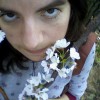Mapping
See the veins in your wrist, blue stitched map lines, delicate and dark where they cross. See the veins in your hands. See, if you can, the blue lines elsewhere on your body. No doubt you’ve seen your blood – dropping from a cut, filling a vial. Consider a razor slicing your skin. Gently, like peeling a piece of fruit. See the razor fight your skin’s natural give. The pain is secondary; what matters is the act, the change, the new map lines. I am as uncomfortable writing this as you are reading it.
“Any desire to harm anybody else?” they will ask you in the emergency room. And you will shake your head. Of course not. Your body will tell the doctors many things, but it can’t tell them everything. You and the Devil are allowed your secrets.
Right now I’m in a therapy group in a hospital. Strangely, despite all the cutting that’s talked about, I don’t see a whole lot of scars. Girls wear short sleeves and short skirts, showing shapely calves and in many cases tattoos. One girl has a forearm covered by a bare-breasted mermaid, a vision of one body on another. Another girl draws intricate faces in pen on the skin of her leg during idle moments in group. I have a “worry groove” – a crescent moon in my palm, from the pressing nail of my middle finger. What we see of our bodies and what we talk about are burdens, unsightly pools of flesh that we have to drag around like sacks. Many of us have undergone an eating disorder at one point or another, and if we haven’t, most of us are girls and we carry weight loss fetishes.
Anything that can call to mind a troubled spot in your life is considered a trigger – a certain song, a picture on a billboard, something someone else says. We talk about triggers a lot. We work backwards through the events of our lives to get to that one little action that sprung the Rube Goldberg machines of our brains into motion. Is it the mother? Is it the father, the sister? Who has ruined us? Our limbs contract and bend into themselves like we’re folding chairs.
I cut on my stomach, because it’s easy to hate the stomach. I already have star-shaped indentations from picking at my flesh when I’m bored. Even the mildest mutilation, picking or scratching or pressing, can be considered an echo of parasuicidal behavior. The para- is important, because we may not actually want to kill ourselves. We just want to wear the pain somewhere on the outside. And scars do tell stories, because you have to walk through stories to get to them – stories being events with beginning, end, and some action in the middle. This white stripe across my stomach is because of an uncommonly beautiful girl at the poetry reading I went to last night, a girl who makes me want to bleed. After I cut I see the sunshine in my room. I go jogging and feel uncommonly hopeful.
“I don’t think it’s about the self-harm or even the pain anymore,” says a friend of mine. “I think it’s about the look.” Another group member points out that beauty, what many people and cultures think of as beautiful, is being able to see what you feel. He asks if she’s tried drawing.
No one among us has bitten herself, or bruised herself, or set herself on fire. We do not want to be brutal to our bodies. We only want our outside flesh to participate in that inside feeling when our lives spiral out of control. If our heart screams something we don’t have words for, this is the way we write it down. This is the way we absolve ourselves for eating too much chocolate. This is the physical manifestation of the money we are costing our beleaguered parents. This is clarity.
Cigarette burns dot our arms as reference points. We go from here, to here, to here. Every cigarette break we gather outside, sucking in the only vice that we are permitted, telling our stories with overlapping words. Do we have a plan for this weekend? A contract? A person to call? Do we have enough money to buy a cup of coffee from the street vendor? We clink together change and take our too-warm cup, bristling because this is pain we didn’t ask for. We reach for a cardboard holder. It’s time to go inside.

